Ijraset Journal For Research in Applied Science and Engineering Technology
- Home / Ijraset
- On This Page
- Abstract
- Introduction
- Conclusion
- References
- Copyright
Augmented Reality In Human Life
Authors: Shivam Sharma, Saud Shaikh
DOI Link: https://doi.org/10.22214/ijraset.2022.43122
Certificate: View Certificate
Abstract
Augmented Reality frequently defined as a system that comes with three basic features: a mixture of real and virtual worlds, real-time interaction, and accurate 3D registration of virtual and real objects. In past few years, the rapid development of augmented reality technology has attracted people\'s high attention. The association of historical advances in Augment Reality (AR) techniques with small and affordable technologies (e.g., sensors, displays, and input devices) we are on the threshold of AR becoming an productive tool for many applications and even everyday life. Primarily AR research has focused on creating technologies, algorithms, and techniques to realize demonstrations that we evaluate with engineering benchmarks, like performance of a tracking system, photorealism of the graphics, and human performance completing a task[2].
Introduction
I. INTRODUCTION
AR has its origin from the word ‘Augment’ meaning to add or enhance. The term Augmented Reality was given by Boeing Experimenter, Tom Caudell. Augmented Reality (AR) is lapping or accelerating of digital images on real world objects using various AR apps. AR strengthen one’s understanding of the real world. Augmented Reality comprise in ‘overlaying virtual imagery onto a physical world scene’. As a result, ‘AR allows the user to see the real world, with virtual objects overlaying upon or amalgamated with the real world. Thus, AR [Augmented Reality] supplements reality, rather than fully replacing it’.[3]
AR can be defined as the system in which real and virtual worlds have been combined, there is real time interaction, and the device is registered in 3D. Here, augmentation is being done in real time. One can say that AR is a technology in between the real reality and the virtual reality.

The specialized means it uses include Multimedia, 3D-Modelling, Real-time Tracking and Registration, Intelligent Interaction, Sensing and further. Its idea is to apply computer-generated virtual information, similar as text, images, 3D models, music, video, etc., to the real world after simulation. In this way, the two kinds of information complement each other, therefore achieving the improvement of the real world. [4]
In recent times, further and further internationally famed research institutions, universities and enterprises have invested in the exploration of AR, published lots of papers and scientific exploration results. These results demonstrate the feasibility and invention of AR as mortal-computer commerce technology. With the enhancement of calculating power of computer software and hardware, AR has gradationally shifted from the theoretical exploration stage of the laboratory to the stage of mass and assiduity operation, and as a ground between the digital world and the real world, it provides people with a new way to fete and witness the effects around. In addition, it has been listed as one of the top ten most promising technologies in the future by authoritative associations similar as the American Times Weekly[5]
Various bias can display AR, and the list is only growing: defenses, specs, handheld and mobile bias, and head-mounted displays. In perception what AR is, it’s also important to understand what it is not. AR is not a completely immersive experience like virtual reality (VR). While virtual reality requires users to slip a special headset and pulls them into a fully digital world, AR lets them continue interacting with the physical world around them. [6]

AR consist of graphics, sounds and touch feedback which are then added to the real world. This creates an enriched user experience. Overall, AR helps to improve user experience, helps in spreading knowledge, education and health. AR involves the concepts of Computer Vision and Computer Graphics. It require vision to get a clear understanding of the real world and needs graphics to create false elements to augment it.
Firstly, the real world is captured. The real world is the target. Also, the virtual world is modelled. Eventually, the digital information or the virtual world is augmented or projected on the target. This is how AR is achieved.
Augmented Reality is not a concept of yesterday. It has come a long way. It began its journey from the year 1968. Table I shows the development of Augmented Reality. There are four different types of Augmented Reality (AR) which are,
- Marker based AR
- Marker less AR
- Projection Based AR
- Superimposition Based AR
A. Marker Based Augmented Reality
This type of reality is also known as Image Recognition. A camera and a visual marker such as a QR code or a 2D code is used. First the marker is recognize by the reader and then the output is given. Apps derive from this type uses a camera to differentiate a marker from any other real world object. Markers can be anything which are distinctive yet simple (e.g. QR Code) and should be observable by the camera. Calculations of position and orientation is done. Marker Detection Algorithm includes Dividing images in regions, Detecting images in the region, Finding segments in the region, Merging segments into lines, Extending lines along the edges, Keeping lines with corners and finally, Finding the markers.[7]
B. Marker Less Augmented Reality
This type of reality is also known as Location-based reality or GPS. Data provided which is based on our location and is provided with the help of a digital compass, accelerometer, velocity meter or GPS. All these are inserted in our devices. The reality of this type is possible because of the location detection features available on our smartphones these days. It recognizes things that were not directly provided to the application in advance, unlike Marker Based AR. Here, the algorithm only has to identify the patterns, the colors, and the other features in order to provide results.
Table I Evolution of Augmented Reality
|
|
||
|
1974 |
|
||
|
1990 |
|
||
|
1992 |
|
||
|
1994 |
|
||
|
1999 |
|
||
|
2000 |
|
||
|
2009 |
|
||
|
2014 |
|
||
|
2016 |
|
||
|
2017 |
|
||
|
2019 |
Microsoft announces HoloLens 2 |
C. Projection Based Augmented Reality
As the name suggests, artificial light is projected onto real- world objects . This allows for human interaction by sensing the touch of that projected light. User’s touch is detected by distinguishing between an expected projection and an altered projection. A digital operating canvas is created on virtually any work surface. Projection based AR is used to project a 3D interactive hologram.
D. Superimposition Based Augmented Reality
In this type of reality, the original view of an object is either incompletely or completely replaced with a recently stoked view of that same object. Then, object recognition plays an important part. E.g. IKEA - Augmented Reality Furniture roster. It is a virtual cabinetwork app that augments cabinetwork onto real bottom.
II. ADVANTAGES AND DISADVANTAGES OF AR
AR is useful and positive at one place but has many disadvantages too. Table II shows the advantages and disadvantages of Augmented Reality.[9]
|
ADVANTAGES |
DISADVANTAGES |
|
AR can be used to expand the knowledge of people. |
AR’s reachability is irregular in social situations. |
|
AR can help people share experiences over fair distances. |
There are no powerful safety features in this technology. |
|
AR has a form of escapism[6]. |
AR has a feature of spam |
|
A life-like experience can be created by AR games. |
There are many concern like that of performance, alignment and interaction. |
Table II. Advantages and Disadvantages of AR
III. APPLICATIONS OF AR IN HUMAN LIFE
AR is being increasingly used in such industries as those listed below:[8]
A. Education
AR is helping students to achieve strengthen learning results through visualization and full immersion in subject matter. Rather than reading about theory in books, students can see and engage with these concepts in real-time. Hence, education becomes more accessible, mobile and fun.
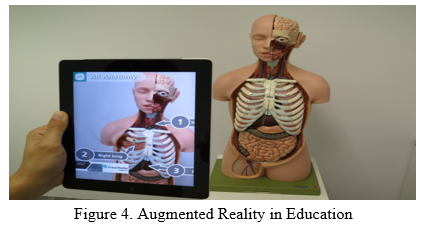
B. Medicine
Make use of AR applications that were first introduce at institutions like Stanford, Duke and Johns Hopkins, The University of Maryland is prototyping the application of AR in medicine. For case in point, surgeons, using AR headsets such as Microsoft’s HoloLens, are able to see key patient data and digital images (e.g., details of a patient’s aneurysm) superimposed over the surgeon’s field of view. This allows the physician to remain concentrated on the operative task without looking away to different multiple displays for more information.
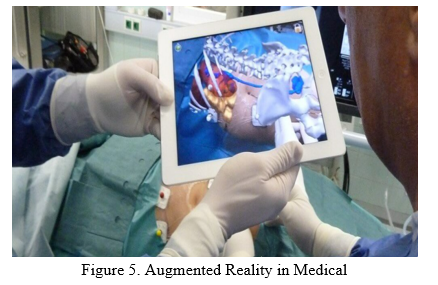
C. Retailing
By using AR, consumers can know the dimension and aspect of the product in realistic ways before copping online, including how the product will look and serve in the buyer’s asked position. For case, with the app Dulux Visualizer, consumers can try out a shade of makeup for their room before they buy it. Using a smartphone camera, they would overlook the room and nearly paint it with any color.
D. Professional Training
AR’s accurate reduplication and simulation of on-the- job conditions can help workers master the practical chops needed for their jobs. This includes allowing similar professionals as preceptors, dogfaces, croakers and police officers to exercise and hone new chops before applying them in real situations.
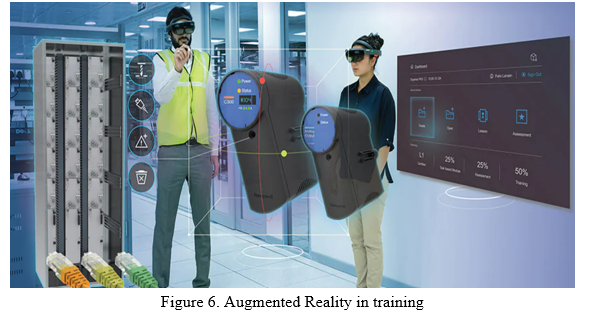
E. Auto Repair
Using an AR app via a mobile phone or tablet, mechanics making repairs on moment’s largely complex vehicles can see superimposed imagery and information on their device, allowing imperfect corridor to be located hastily and repairs to be broken down into a series of simple way.
F. Entertainment and Games
Augmented Reality can be proved to be a turning point for entertainment and games. Here, it is possible to interact with the real world and reel world using this technology. AR can be used in Television Broadcasting. Many sports channels use AR thus allowing audience to view graphic overlays. AR is widely used in Gaming too. Apps such as Ingress and Pokémon Go use augmented reality to let gamers play with virtual characters in real world.
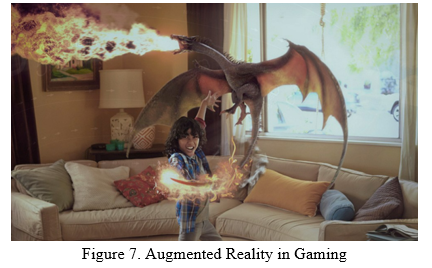
G. Robotics
In this field, AR makes it effortless for robots for communicating complex information to humans. Also, this technology can help robots perform surgeries by combining AR with surgical robot system for performing head surgeries. In a nutshell, AR is a platform that has made mortal-robot collaboration possible
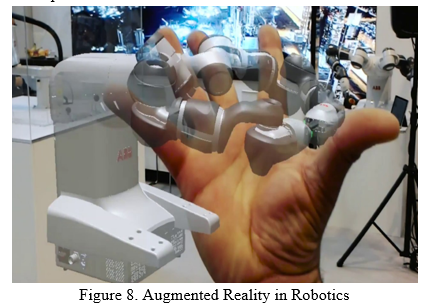
H. Travel and Lifestyle
Moment we browse websites or Instagram to learn about trip destinations. Hereafter we ’ll have immersive 3D vids that recreate the experience of being in Thailand or Bali — from the comfort of our living room
I. Food and Cooking
New apps like Kabaq enable consumers to see realistic virtual 3D food on their table in caffs or ordering online. Unborn apps will combine smart kitchen appliances with interactive turn-by- turn fashions. They ’ll give you audio/ videotape guidance for each step of a form and show you how to plate and present your dishes
J. Beauty and Fashion
Smart Glass apps like Memomi Labs will let you try on clothes, makeup, change hair color — nearly. The positive result of Snapchat lenses suggests this will be another huge area for AR apps.
IV. AUGEMENTED REALITY AND VIRTUAL REALITY
As we know that Augmented Reality is a emulsion between the real world and the digital world. On the other hand, there's Virtual Reality. It's an artificial, computer generated recreation of a real world situation. One can say that AR and VR are inverse reflections of one another in terms of what they want to achieve and deliver to the stoner. And because both of the technologies are connected with one another there are some of the parallels and differences between them which have been described below. (9)
A. Similarities
- Technology. Analogous type of technology is being used by both AR and VR. They both do to serve the society with an boosted experience.
- Entertainment. With AR and VR, the user has a control on the artificial or virtual worlds. The user can interact deeply with the reality.
- Science and Medicine: Both AR and VR have the capacity to change the aspects of medical field i.e. by making remote surgeries possible. These technologies have formely been used to treat conditions similar as PTSD (Post Traumatic Stress Disorder).
B. Differences
- Purpose: Both the technologies have different purposes. AR magnifies user experience by adding virtual factors similar as visual overlays as a new subcaste of commerce with the real world. Whereas VR shapes its whole new reality which is purely computer-grounded.
- Delivery System: AR is generally used in mobile bias similar as laptops, smartphones, and tablets. It is used in such a way so as to change the way real world and digital images interact and cross. While VR uses HMDs i.e. head-mounted displays or hand-held regulators.
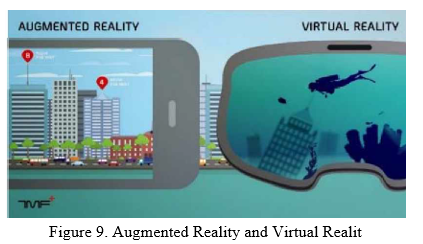
V. AR ENHANCEMENT
A. AR and Shopping
One of the important trends is the use of AR assisted shopping apps. We know that in the coming years 100 million of people are going to use this technology. In a Survey conducted in a study, 50% of people stated that they would like to shop from a retailer who uses AR technology. AR integrated with Shopping can boost the economy.
B. AR in Navigation
We know that in outdoor navigation Google Maps dominates the market. But there are not many forays made on the indoor navigation. If we are in a large hospital, airport, campus, you will get to know that people get confused to find their way to the destination. AR can give detailed information and people will use it with ease because technology will give 3D rendering of places with accurate instructions on where to go.
C. AR with AI:
The two important industries if integrated together can boost the computation and healthcare sector. Human machine systems integrated with AR-AI team can accurately predict outcomes, diagnose disease, and suggest the best course of action to the doctors.
D. AR and Search Engines
Augmented Reality can promise a futuristic browsing experience to the users. When you open any app your camera will get activated and the content will be displayed in 3D form which will enhance the user experience.
Conclusion
Above mentioned, we have studied about Augmented Reality and its various application in the field of medical, education, entertainment & games, robotics, food and cooking, beauty, travel and fashion. We acquired knowledge about some apps such as Memomi, Kabag, etc. that use this technology of AR. We also concluded how the use of AR can be beneficial in our day to day lives. The technology of AR still under exploration and development and is arising day by day. Many things have been developed lately using this technology. It has entered the world of car repair again after 5 years. [10] The main research findings afforded that AR can be seen as a new communication medium or tool in an early stage level due to several major social and technical challenges and that it goes along with the emerging information technology. One of the most promising devices for AR applications is the mobile phone which could open the floodgates for the mass implementation of AR.[11] In a nutshell, it can be said that AR has a very bright and promising future in spite of having many threats to its success in the near future
References
[1] Infographic: The History of Augmented Reality, http://www.augment.com/blog/infographic-lengthy-history-augmented-reality/ [2] R. Aggarwal and A. Singhal, \"Augmented Reality and its effect on our life,\" 2019 9th International Conference on Cloud Computing, Data Science & Engineering (Confluence), 2019, pp. 510-515, doi: 10.1109/CONFLUENCE.2019.8776989. [3] José María Ariso (Ed.)_AUGMENTEDREALITY-Berlin Studies in Knowledge Research [4] https://en.wikipedia.org/wiki/Augmented_reality [5] https://www.threekit.com/blog/what-is-augmented-reality [6] ]https://psu.pb.unizin.org/ist110/chapter/6-2-augmented-reality/ [7] Marker Based Augmented Reality, https://www.slideshare.net/arshiyasayd/marker-based-augmented-reality [8] Mekni, Mehdi, and Andre Lemieux, \"Augmented reality: Applications, challenges and future trends.\" ,Applied Computational Science— Proceedings of the 13 th International Conference on Applied Computer and Applied Computational Science (ACACOS ‘14) Kuala Lumpur, Malaysia. 2014: pp. 205, 207 - 209. [9] Virtual reality vs. Augmented Reality, http://www.augment.com/blog/virtual-reality-vs-augmented-reality/ [10] https://www.researchgate.net/publication/338371625_Augmented_and_Virtual_Reality_Evolution_and_Future_Tendency [11] Augmented Reality is the future of design, https://thenextweb.com/augmented-reality/2015/08/31/augmented-reality- is-the-future-of-d
Copyright
Copyright © 2022 Shivam Sharma, Saud Shaikh. This is an open access article distributed under the Creative Commons Attribution License, which permits unrestricted use, distribution, and reproduction in any medium, provided the original work is properly cited.

Download Paper
Paper Id : IJRASET43122
Publish Date : 2022-05-23
ISSN : 2321-9653
Publisher Name : IJRASET
DOI Link : Click Here
 Submit Paper Online
Submit Paper Online

